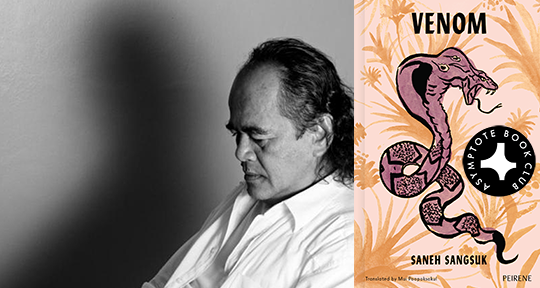A story about the dissolving borders between human and animal, life and death, love and cruelty, Venom by Saneh Sangsuk is a kind of philosophical fairy tale, with both danger and beauty always lurking at its edges. Told through shifting perspectives in poetic prose, this slim novel is densly packed with ideas and energy, providing a thrilling introduction to Sangsuk’s work for English-language readers.
The Asymptote Book Club aspires to bring the best in translated fiction every month to readers around the world. You can sign up to receive next month’s selection on our website for as little as USD20 per book; once you’re a member, join our Facebook group for exclusive book club discussions and receive invitations to our members-only Zoom interviews with the author or the translator of each title.
Venom by Saneh Sangsuk, translated from the Thai by Mui Poopoksakul, Peirene Press, 2023
The world is full of poetry; the world is full of cruelty—this is not a contradiction. As I read Saneh Sangsuk’s deceptively slim novel Venom, I was reminded of Laura Gilpin’s “Two-Headed Calf.” At barely nine lines, Gilpin’s poem also has depth that reaches far beyond its brevity. The first stanza begins with a warning (that the idyllic pastoral will soon be disrupted), while the final stanza establishes a heart-wrenching and melancholic portrait of a recently-born, two-headed calf revelling in the light of the moon, “the wind on the grass,” and the warmth of its mother. The beauty of Gilpin’s poem lies in the way it holds two worlds in its lines, but also in how it makes possible for a cruel tomorrow to never arrive. In a sense, by returning to this poem, we are returning to a moment in another world where a two-headed calf—this “freak of nature”—is frozen in an eternal evening of joy and love.
I found in Venom the same sensations, the same negotiation between poetic beauty and cruelty. The former comes quickly and easily, as the book opens with a little boy contemplating a mesmerizing sunset in the Thai countryside: “Over the horizon to the west, the clouds of summer, met from behind by sunlight, glowed strange and lustrous and beautiful.” Additionally, the first thing we learn about this boy is that he was granted the privilege of naming his family’s eight oxen, and he had been eager to fulfil this task with care and artistic flare. He calls the animals by names like “Field, Bank, Jungle and Mountain—Toong, Tah, Pah and Khao,” and “Ngeun and Tong, Silver and Gold,” or “Pet, Ploy, Ngeun and Tong.” These group of names speak to him with prosodic logic: some rhyme, and others provide a chance for alliteration. All in all, they belong to a group of words that “sounded like [they] could be poetry,” a phrase that Sangsuk repeats twice. This act of naming, the author suggests, is an act of writerly creation. While the world is not inherently poetic, some people are more prone to make poetry from its elements. READ MORE…

